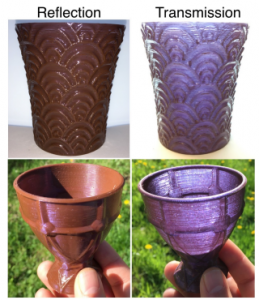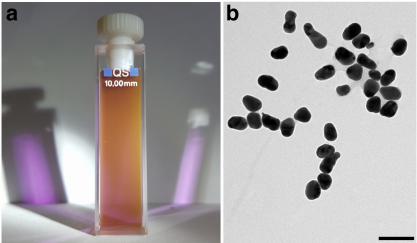Nanotechnology may seem novel and advanced, but it has actually been used for thousands of years. Metallic nanoparticles are present in glass and pottery from hundreds and thousands of years ago, giving the items a shiny, glittering look. In a paper entitled “Plastic embedded gold nanoparticles as 3D printing dichroic nanocomposite material,” a group of researchers discusses how they fabricated a 3D printable nanocomposite composed of dichroic gold nanoparticles and a 3D printable polymer.
“Dichroic AuNP (gold nanoparticles) were prepared using a modified Turkevich method, thus reducing gold ions to gold nanoparticles using citrate as both reducing and capping agent,” the researchers explain. “In the classical Turkevich method, a boiling chloroauric acid solution is reacted with citrate using a molar ratio citrate to gold of 10, producing AuNP of around 10 nm. When this ratio is changed, the size of the obtained nanoparticles changes as well. We discovered that a citrate/gold ratio between 0.6 and 0.8 produced dichroic nanoparticles that showed a brownish reflection and a purple transmission.”
The nanoparticle solution was studied by transmission electron microscope (TEM).
“The presented synthesis is easy and fast, as it takes only few minutes to obtain the dichroic solution after the addition of the citrate,” the researchers continue. “During the synthesis, the solution changed color multiple times: the yellow solution of the gold ions become blue one minute after the addition of the citrate solution. Two minutes later, the solution showed an intense black color, before becoming dichroic after another two minutes of boiling. The color changed during the synthesis hint that the dichroic nanoparticle formation is not just seeded growth, but a more complex mechanism.”
Once the gold nanoparticle solution was prepared, the nanoparticles were embedded in a 3D printable material that could be used with a standard off-the-shelf FDM 3D printer. The researchers used polyvinyl alcohol (PVA) as the carrier, as it is one of the most commonly used 3D printing materials, it is water soluble and can thus be mixed with the nanoparticles without need of changing solvent, and because it can be used as a capping agent for nanoparticles.
 The researchers compared TEM results of the original dichroic solution to the AuNP-PVA dissolved in water, and found that the nanoparticles were still of the same size and shape as the original ones, showing that the embedding in PVA does not influence the stability of the nanoparticles. Finally, they extruded the material to create a filament for FDM 3D printing. The small percentage of gold did not affect the printability of the PVA. The researchers then 3D printed a replica of the fourth-century Lycurgus cup and coated it in PDMS so it could hold water.
The researchers compared TEM results of the original dichroic solution to the AuNP-PVA dissolved in water, and found that the nanoparticles were still of the same size and shape as the original ones, showing that the embedding in PVA does not influence the stability of the nanoparticles. Finally, they extruded the material to create a filament for FDM 3D printing. The small percentage of gold did not affect the printability of the PVA. The researchers then 3D printed a replica of the fourth-century Lycurgus cup and coated it in PDMS so it could hold water.
“In conclusion, we showed how to synthesize and embed dichroic nanoparticles in 3D printable material,” the researchers conclude. “The AuNP-PVA nanocomposite is mechanically similar to the bare plastic and its dichroic optical properties are similar to the one shown by the AuNP solution. The 3D printed objects can be coated to achieve water impermeability and stability at room temperature for long time. We can envision this methodology to be used not only by artists, but also for studying optical properties of nanoparticles or, for example in 3D fabrication of optical filters.”
Authors of the paper include Lars Kool, Anton Bunschoten, Aldrik H. Velders and Vittorio Saggiomo.
Discuss this and other 3D printing topics at 3DPrintBoard.com or share your thoughts below.
Subscribe to Our Email Newsletter
Stay up-to-date on all the latest news from the 3D printing industry and receive information and offers from third party vendors.
Print Services
Upload your 3D Models and get them printed quickly and efficiently.
You May Also Like
Making 3D Printing Personal: How Faraz Faruqi Is Rethinking Digital Design at MIT CSAIL
What if your 3D printer could think more like an intelligent assistant, able to reason through a design idea, ask questions, and deliver something that works exactly the way the...
Reinventing Reindustrialization: Why NAVWAR Project Manager Spencer Koroly Invented a Made-in-America 3D Printer
It has become virtually impossible to regularly follow additive manufacturing (AM) industry news and not stumble across the term “defense industrial base” (DIB), a concept encompassing all the many diverse...
Heating Up: 3D Systems’ Scott Green Discusses 3D Printing’s Potential in the Data Center Industry
The relentless rise of NVIDIA, the steadily increasing pledges of major private and public investments in national infrastructure projects around the world, and the general cultural obsession with AI have...
Formlabs Teams Up with DMG MORI in Japan
In late June, Nick Graham, Chief Revenue Officer at Formlabs, announced on LinkedIn that the company had partnered with DMG MORI, one of the world’s leading machine tool companies, to...



































